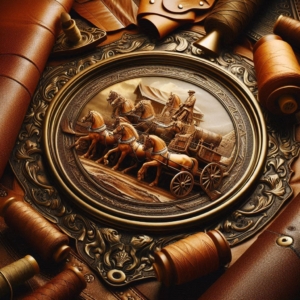Leather in Fashion: A Beginner’s Guide to Its Evolution
Leather in Fashion: A Beginner’s Guide to Its Evolution
Leather is more than just a material; it’s a historical artifact that tells the story of human progress and style. Let’s take a stroll down memory lane and see how leather has shaped our wardrobes and withstood the test of time.
From Survival to Style: The Early Days
Imagine it’s 50,000 years ago. You’re a Cro-Magnon person, and it’s freezing outside. What do you do? You turn to the most reliable source of warmth and protection available: animal skins. This was the birth of leatherworking, where early humans treated skins with tree bark and animal fat to make them soft and wearable1.
Leather as a Status Symbol in Ancient Times
Fast forward to ancient civilizations like Sumeria and Mesopotamia, where leather wasn’t just for staying warm—it was a fashion statement. High-status women wore leather garments as early as the 5th to 3rd millennia BCE. Even a well-preserved loincloth from 1580 to 1350 BCE shows us that leather was the ‘it’ material of the time1.
The Art of Oil Tanning with Native Americans
When European settlers arrived in North America, they learned the art of oil tanning from Native Americans. This technique allowed them to create white leather, which is quite tricky to achieve. Native Americans were true artisans, decorating their leather with bones, feathers, and beads1.
Leather’s Big Break: The Industrial Revolution
The Industrial Revolution was a game-changer for leather. Suddenly, there was a massive demand for it—not just for clothes and shoes but also for the belts that powered machines. Communities grew around tanneries, and the leather industry became a cultural phenomenon1.
The 19th Century: A Tanning Revolution
In the 19th century, an American chemist named Augustus Schultz discovered that chromium salts could speed up the tanning process. This breakthrough meant that tanning, which used to take weeks or months, could now be done in hours. It was a big deal for the leather industry1.
Leather Trading and Guilds: Protecting the Craft
Leather was so important that trade guilds formed to protect the interests of craftsmen and control the supply of materials. From Ancient Greece to the Middle Ages, leather was essential for making everything from sandals to armor1.
Leather Today: Still a Fashion Staple
Today, leather is everywhere. It’s in men’s and women’s wardrobes, from practical items to high-fashion pieces. Leather jackets, in particular, have weathered many fashion storms to remain iconic1.
Looking Ahead: Leather and Sustainability
The leather industry is evolving with a focus on sustainability. Brands are innovating with recycled materials and chrome-free leather. There’s even vegan leather made from mushrooms, and big names like Adidas and Nike are on board with these eco-friendly trends1.
Leather Trends to Watch
In 2023-24, leather is still a hot trend, especially in street style. We’re seeing padded leather, textured finishes, and a move towards eco-friendly materials like coffee, seaweed, and fish skins. The ‘worn-out’ leather look is also making a comeback1.
In Conclusion: Leather’s Lasting Legacy
Despite competition from synthetic materials, leather’s versatility and durability make it a mainstay in the fashion industry. It’s not just about looking good; it’s about a material that has stood by humanity through thick and thin.


